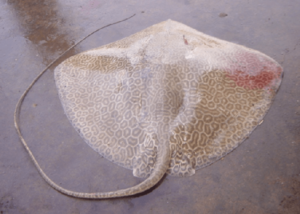Honeycomb whipray facts for kids
Quick facts for kids Honeycomb whipray |
|
|---|---|
 |
|
| Conservation status | |
| Scientific classification | |
| Genus: |
Himantura
|
| Species: |
undulata
|
| Synonyms | |
|
|
The honeycomb whipray (Himantura undulata) is a type of stingray. It lives in the shallow ocean waters of the Indo-Pacific region, from India to the Malay Archipelago. This big ray can grow up to 1.3 meters (about 4.3 feet) wide. It has a flat, diamond-shaped body with a long, thin tail like a whip.
Adult honeycomb whiprays have a cool pattern of dark brown rings and lines on their back, outlined in yellow. Younger rays have large dark spots. A special feature is a big, pearl-like bump in the middle of its back. Sadly, this ray is endangered because of too much fishing and damage to its home.
Contents
Discovering the Honeycomb Whipray
A Dutch scientist named Pieter Bleeker first wrote about the honeycomb whipray in 1850. He called it Trygon undulata. Two years later, in 1852, he officially described the species. He based his description on three rays caught near Jakarta and Semarang in Java. Later, scientists moved this ray into the group called Himantura.
Other common names for this ray include Bleeker's variegate ray. It is also sometimes called the ocellate whipray.
Similar Stingrays
The honeycomb whipray is very similar to two other stingrays: the reticulate whipray (H. uarnak) and the leopard whipray (H. leoparda). They look so much alike that people often confuse them. Sometimes, what people thought was a honeycomb whipray was actually a leopard whipray. These three rays are part of a larger group of similar species.
What Does It Look Like?
The honeycomb whipray has a flat, diamond-shaped body. Its body is a bit wider than it is long. The outer corners are rounded, and its snout is pointed and sticks out. Its eyes are small, and right behind them are two larger holes called spiracles. These help the ray breathe.
Its mouth is shaped like a bow. Inside, it has small teeth and two nipple-shaped bumps on the floor of its mouth. Its tail is thin and looks like a whip. It is about twice as long as its body. The tail usually has one sharp, stinging spine near its base.
Skin and Patterns
Adult rays have a wide band of small, flat bumps on their skin. These bumps run from between their eyes, over their back, and onto their tail. In the middle of its body, there is one large, round, pearl-like bump. Behind it are two or three smaller thorns.
When they are born, honeycomb whiprays have large, dark spots on their body. As they get older, these spots change into a pattern that looks like a honeycomb. This pattern has large, dark rings and lines separated by thin yellow lines. The tail has dark and light bands. The underside of the ray is white. This species can grow to be about 1.3 meters (4.3 feet) wide.
Where It Lives
The honeycomb whipray lives in the warm, tropical waters of the Indo-Pacific region. This includes areas from India to Taiwan and New Guinea. However, it does not seem to live off the coast of Australia.
This ray lives on the bottom of the ocean, in shallow coastal waters. It likes places with soft sand or mud. You can find it in lagoons, estuaries (where rivers meet the sea), and mangrove swamps.
Life and Reproduction
Scientists don't know a lot about the daily life of the honeycomb whipray. It usually rests still on the ocean floor. Sometimes, it buries itself partly or completely in the sand or mud. It probably eats small crustaceans, like crabs, and small fish.
Like other stingrays, the honeycomb whipray gives birth to live young. The mother provides food for her developing babies inside her body. Newborn rays are about 26 to 27 centimeters (10 to 11 inches) wide. Male rays become old enough to reproduce when they are about 60 to 70 centimeters (24 to 28 inches) wide.
Threats to the Honeycomb Whipray
Many people catch the honeycomb whipray for food. Fishermen use different types of nets, like tangle nets and bottom trawls. Sometimes they also use longlines. The ray's meat is sold, and its skin and cartilage might also be used.
Fishing is increasing in many areas where this ray lives, like the Gulf of Thailand. The honeycomb whipray is especially at risk because it lives in shallow coastal waters. These areas are also affected by pollution and damage from coastal buildings. Because of these threats, the International Union for Conservation of Nature (IUCN) believes the number of honeycomb whiprays has gone down. They have listed it as an endangered species.



